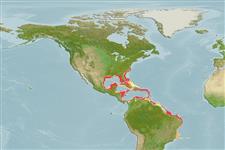Common names from other countries
Environment: milieu / climate zone / depth range / distribution range
Sinh thái học
Cùng sống ở rạn san hô; Mức độ sâu 1 - 192 m (Ref. 83934). Tropical; 35°N - 21°S, 90°E - 32°E (Ref. 83435)
Western Atlantic.
Length at first maturity / Bộ gần gũi / Khối lượng (Trọng lượng) / Age
Maturity: Lm ? range ? - ? cm Max length : 3.4 cm DL con đực/không giới tính; (Ref. 83435)
Maximum depth from Ref. 109264. This species is found in intertidal and offshore coral reefs, particularly on algae, coral, gravel, rock, sand, shells, and sponge habitats (Ref. 83934).
Life cycle and mating behavior
Chín muồi sinh dục | Sự tái sinh sản | Đẻ trứng | Các trứng | Sự sinh sản | Ấu trùng
Members of the order Archaeogastropoda are mostly gonochoric and broadcast spawners. Life cycle: Embryos develop into planktonic trocophore larvae and later into juvenile veligers before becoming fully grown adults.
Rodríguez-Sevilla, L., R. Vargas and J. Cortés. 2009. (Ref. 83934)
IUCN Red List Status (Ref. 130435)
CITES status (Ref. 108899)
Not Evaluated
Not Evaluated
Human uses
| FishSource |
Các công cụ
Thêm thông tin
Age/Size
Sự sinh trưởng
Length-weight
Length-length
Hình thái học
Ấu trùng
Sự phong phú
Các nguồn internet
Estimates based on models
Preferred temperature
(Ref.
115969): 21.1 - 27.5, mean 25.2 (based on 160 cells).
Price category
Unknown.
